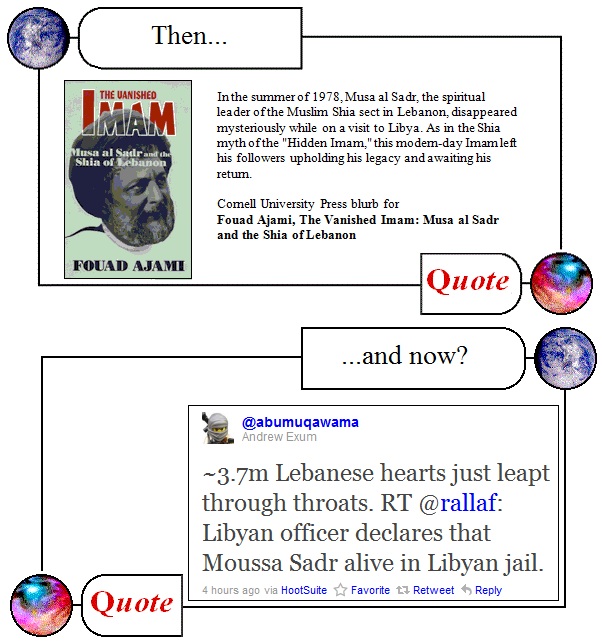Return of the Vanished Imam?
Fouad Ajami’s The Vanished Imam: Musa al Sadr and the Shia of Lebanon was among the first books I read about matters Islamic, and the close parallel between the vanishing of Musa al-Sadr and the vanishing — or, more properly speaking, Ghayba or occultation — of the Twelfth Imam or Mahdi struck me forcibly at the time.
I don’t have my copy to hand, so I can’t tell how strongly Ajami himself made the comparison — but I was certainly not alone. Daniel Pipes, in his review of Ajami’s book writes:
What made the Imam’s vanishing so significant is that it exactly fit the millennial expectations of Shiism, a faith premised on the disappearance of righteous leaders and their reappearance at the end of time.
And now it may be — the report has yet to be confirmed — that Imam Musa is back among us.
@rallaf is an Associate Fellow at London’s Chatham House.
*
The mind sees one thing, which reminds it of something else. It’s the oldest trick in the book, and it depends on the recognition of pattern, or you might say, parallelism.
The return of Imam Musa would be significant not merely for his admirers, not only for what he might have to say or what role — now aged 82, after 30 years in prison — he might yet play, but also, I suspect, for the vivid premonition of the Mahdi his return might stir…




February 26th, 2011 at 1:10 am
Time has an article up about this: http://www.time.com/time/specials/packages/article/0,28804,2045328_2045333_2053630,00.html
February 26th, 2011 at 9:13 am
Thanks, Curtis.
.
I ordered a used copy of Ajami’s book and it arrived in the mail today — my old one is in storage someplace inaccessible.
.
I’m glad people are taking notice of the impact of individuals — Musa al-Sadr, Dr Fadl, and no doubt there are plenty of others — in these times when there are enough nations competing for press attention that some of them tend to get lost in the crowd…
February 26th, 2011 at 9:51 am
I’d wanted the book to see how Ajami treated the parallelism between al-Sadr’s disappearance and the ghayba of the Twelfth Imam. Here’s a paragraph or two from his Prologue, which is not easy to excerpt from:
There’s a paragraph in his concluding pages, too, that bears consideration. In some ways, the Ayatollah Khomeini picked up more violently in Iran on an activism that Musa al-Sadr had pioneered in the Lebanon. Ajami writes:
Ajami’s book has a 1986 copyright.